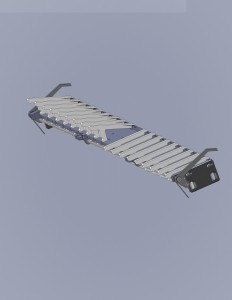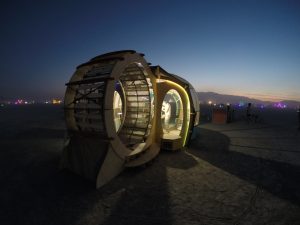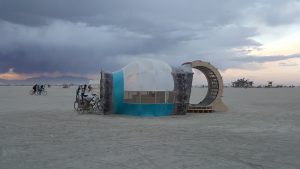2016 Mechanica Musica
Wheel & Base with Pin Actuator Assemblies

Actuator Pin Assembly

Vitruvian Dan

Evening on the Playa

Hammer & Keys

Daytime Playa

Human-Powered, Programmable Music Box
This is a giant, programmable human-powered music box. Participants can choose from several preset songs or use a keyboard to enter their own compositions. Each composition will form a musical ‘seed’ which we will process into instructions for two write-heads to control the settings of 1296 individual pins to play the music. Using music theory & historical music types, we will use each seed to generate a new composition that will continue & evolve as long as the participant walks inside the wheel.
Da Vinci’s genius extended to every scientific & artistic field, including music. He was known as a skilled composer & performer, and some historians believe that he first impressed his patrons in Milan with his musical talents as a singer, flautist, & lyre player. Later, he went on to invent musical instruments including the viola organista: a complicated keyboard instrument with strings, & the mechanical drum: a rolling percussion device used to entertain crowds at high-society parties.
In spite of his love of music, Da Vinci felt that, “Music may be called the sister of painting, for she is dependent upon hearing, the sense which comes second…painting excels & ranks higher than music, because it does not fade away as soon as it is born.” In our modern era, when high definition video recorders are ubiquitous & Spotify and YouTube can bring us the world’s entire catalog of recorded music, the sister of painting is no longer second fiddle.
Each piece will be unique & will be carried away only by the wind & the memories of those who were there to hear it. We wish to give every participant the chance to create, in concert with us, a unique & beautiful piece of music to share with those around them. What better place than Burning Man to celebrate Da Vinci’s love of the second sister & complex mechanical mechanisms in one project?
As the wheel spins, a pin-setting mechanism will release all of the pins in a row. Torsion springs will push them all into the up position. This will trip an external sensor that will let the write-heads know that it is time to set the pins. Pins that are not going to strike hammers are pushed down by the solenoids. The locking bar then re-engages all of the pins and holds them in their new state until they can set the hammers which will be actuated much as piano hammers are, and strike the Marimba keys. The user will then experience the music that they have, literally, set in motion.
The structure will consist of an 8-foot diameter steel “human hamster wheel” (HHW) on a structural steel base. The wheel will be completely covered with 72 pin assemblies, each containing a locking mechanism & 18 pivoting pins. These pins will be set into either an up or down position by the write heads. Up means that a hammer will be cocked & will strike a marimba key, thus playing an individual note. The marimba keys themselves will have wooden resonators in order to amplify the sound of each note. Except for these wooden resonators, there will be no amplification of the sound produced by the keys.
The base will act as the ground tie-point, bearing housing & external frame support for the musical keys & hammers. The sides will be covered with decorative panels, both for aesthetics and to keep fingers away from moving parts. The control computer, keyboard & pre-programmed song selection device will be housed in a small kiosk accessible from the wheel so that participants can adjust the music “on the fly.”
Here is what someone else though of our little wheel.

